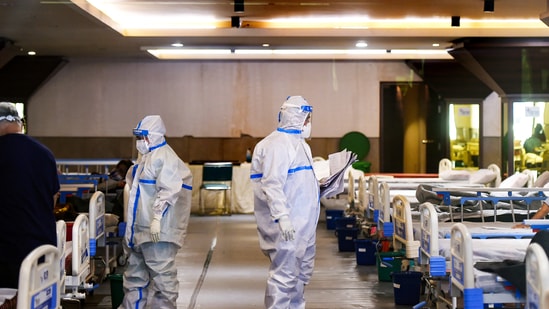Covid-19: Delhi makes new tracing push with revised targets
All district administrations have been asked to trace 30 contacts for each Covid-positive patient in their jurisdiction, a senior Delhi Disaster Management Authority (DDMA) official said.
With Delhi’s Covid-19 case trajectory and positivity rate falling, the state government has given district administrations fresh guidelines for home isolation, and updated their contact tracing targets in an attempt to revive the test-trace-treat system that went on the back-burner due to the unprecedented surge in infections since mid-April.

All district administrations have been asked to trace 30 contacts for each Covid-positive patient in their jurisdiction, a senior Delhi Disaster Management Authority (DDMA) official said.
Between May 15 and 17, the city’s 11 districts traced an average of 31.3 contacts for each person tested positive. With 35.30 contacts per case, east Delhi recorded the highest and west Delhi the lowest with 28.37 per case, showed government records.
Neither Delhi government nor DDMA officials shared contact tracing data for all areas for March and April.
Also Read| On Kejriwal's comment, Singapore says reserve right to invoke fake news law
On March 15, government data showed, districts traced around 32 contacts on an average, against the target of 30 per Covid-19 case.
HT reported last month that the contact tracing process had slowed as cases surged.
With the fourth wave of infections adding record numbers of cases, some patients reached out to control rooms complaining that they did not receive any calls from the administration after they tested positive.
“When things went out of hand, most subdivision level control rooms and dispensary level teams, which were set up to call up patients, could not keep up with the load. Doctors got busy in hospitals, and hardly anyone could be spared to check on home isolation patients, or help with telephonic consultancy on a large scale, even though the government issued helpline numbers from time to time,” said a district surveillance official who asked not to be named.
The Delhi government on Tuesday revised its home isolation guidelines in line with those of the Union health ministry to include people who might be clinically presumed to have a mild case of Covid-19, as well as those diagnosed with mild or asymptomatic infection, in a move to ensure that people get help from the administration, whether or not they have a confirmed Covid-19 test.
At its peak, Delhi recorded 28,395 cases in a day on April 20, while on April 22, the city recorded a test positivity rate of more than 36%. But the surge has eased in recent days, with cases, deaths, and the positivity rate all coming down.
Also Read| Don’t let your guard down, even if Covid wave wanes: Delhi L-G to Kejriwal govt
Delhi on Wednesday recorded 3,846 new cases, the lowest since April 5, while the positivity rate fell to 5.78%, the lowest in 44 days.
The Capital has recorded a daily average of 6,390 cases over the past seven days, down sharply from the average of 15,441 daily infections it added a week ago.
As on Wednesday, Delhi had 45,047 active cases, nearly half of the 82,725 active cases it had a week ago.
The virus has infected 1.4 million people in the city so far, claiming 22,346 lives, state government health records showed.
Experts said the government should take the present decline in cases as an opportunity to strengthen its home isolation and contact tracing systems, and scale up protocols such as triaging before another potential wave.
Triaging is determining the priority of patients’ treatments by the severity of their condition or likelihood of recovery with and without treatment.
“Delhi cannot afford to let things go out of hand. In Covid-19 management, there is no alternative to home isolation and contact tracing. In contact tracing, the government should not only reach out to people, but also guide them in quarantining themselves, test them and isolate the ones who test positive. Delhi now should learn and establish a strong model of triaging at a district model or subdivisional model. And ensure that investment on Covid-19 strategies are data driven,” said Dr Lalit Kant, former head of epidemiology and communicable diseases division in the Indian Council of Medical Research (ICMR).
Dr Jugal Kishore, head of the community medicines department in Delhi’s Safdarjung Hospital, said, “The home isolation system is bound to fail if patients are not monitored through periodic calls and visits. This is an opportunity to strengthen the model. They should also have a triaging model in place.”
Delhi government spokespersons did not respond to requests for comment.
Stay updated with all top Cities including, Bengaluru, Delhi, Mumbai and more across India. Stay informed on the latest happenings in World News along with Delhi Election 2025 and Delhi Election Result 2025 Live, New Delhi Election Result Live, Kalkaji Election Result Live at Hindustan Times.
Stay updated with all top Cities including, Bengaluru, Delhi, Mumbai and more across India. Stay informed on the latest happenings in World News along with Delhi Election 2025 and Delhi Election Result 2025 Live, New Delhi Election Result Live, Kalkaji Election Result Live at Hindustan Times.






